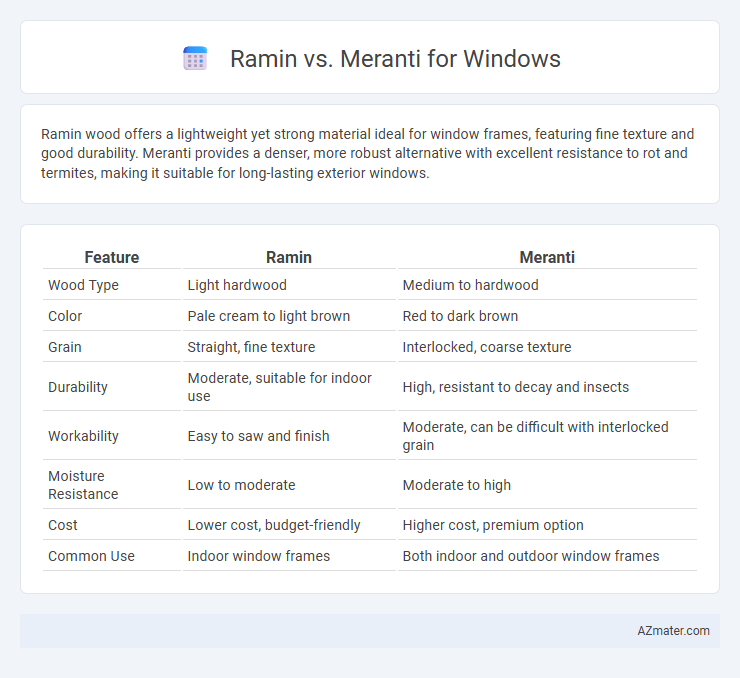Ramin wood offers a lightweight yet strong material ideal for window frames, featuring fine texture and good durability. Meranti provides a denser, more robust alternative with excellent resistance to rot and termites, making it suitable for long-lasting exterior windows.
Table of Comparison
| Feature | Ramin | Meranti |
|---|---|---|
| Wood Type | Light hardwood | Medium to hardwood |
| Color | Pale cream to light brown | Red to dark brown |
| Grain | Straight, fine texture | Interlocked, coarse texture |
| Durability | Moderate, suitable for indoor use | High, resistant to decay and insects |
| Workability | Easy to saw and finish | Moderate, can be difficult with interlocked grain |
| Moisture Resistance | Low to moderate | Moderate to high |
| Cost | Lower cost, budget-friendly | Higher cost, premium option |
| Common Use | Indoor window frames | Both indoor and outdoor window frames |
Introduction to Ramin and Meranti Wood
Ramin wood, sourced primarily from Southeast Asia, is renowned for its light color, fine grain, and smooth texture, making it ideal for window frames and interior joinery. Meranti wood, also native to the same region, is valued for its durability, reddish-brown hue, and moderate hardness, offering excellent resistance to decay and warping in window applications. Both woods are sustainable choices, prized in construction and furniture-making for their workability and aesthetic appeal.
Origin and Botanical Overview
Ramin (Gonystylus spp.) is native to Southeast Asia, primarily Indonesia and Malaysia, known for its lightweight, pale yellow to light brown wood with fine texture and straight grain, commonly used in window frames and moldings. Meranti refers to a group of Shorea species indigenous to the same region, featuring a range of colors from light yellow to reddish-brown, with moderate density and good workability, widely favored in window construction for durability and aesthetic appeal. Both woods originate from tropical rainforests and belong to the Dipterocarpaceae family, with Ramin valued for its smooth finish and Meranti prized for its strength and diverse color palette.
Appearance and Color Differences
Ramin wood exhibits a pale yellow to light brown color with a fine, even texture, giving windows a smooth, uniform appearance, while Meranti offers a broader color range from light reddish-brown to dark red or brown, imparting a richer and more varied visual character. The subtle golden hues of Ramin provide a sleek, contemporary look, whereas Meranti's deeper, warm tones enhance traditional or rustic window designs with greater depth and contrast. Both woods display fine grain patterns, but Meranti's more pronounced grain variation creates a distinctive, textured aesthetic compared to the more consistent finish of Ramin.
Strength and Durability Comparison
Ramin wood offers moderate strength with a Janka hardness of approximately 770 psi, making it suitable for lightweight window frames but less resistant to heavy impacts compared to Meranti. Meranti wood, often classified as a hardwood with Janka hardness values ranging from 830 to 1,290 psi depending on the specific species, provides superior durability and resistance to wear, ideal for high-traffic or heavy-duty window applications. Both woods offer good resistance to decay, but Meranti's denser grain structure enhances longevity and structural integrity under varying environmental conditions.
Resistance to Weather and Pests
Meranti wood offers moderate resistance to weather but is more susceptible to pest attacks compared to Ramin, which is known for its superior durability and natural resistance to termites and fungal decay. Ramin's dense grain structure enhances its weather resistance, making it ideal for window frames exposed to harsh environmental conditions. Although Meranti is more affordable, Ramin's long-lasting performance against moisture, rot, and insects ensures better protection and longevity for windows.
Workability and Ease of Installation
Ramin wood offers superior workability for window frames due to its fine, even texture and low density, making it easier to saw, plane, and nail compared to Meranti. Meranti, while more durable and resistant to moisture, is denser and harder, which can increase installation time and complicate handling during window assembly. Choosing Ramin enhances ease of installation by reducing tool wear and allowing for smoother, more precise cuts essential for high-quality window fitment.
Cost and Availability
Meranti wood is generally more cost-effective than Ramin, making it a preferred choice for budget-conscious window frames. Ramin offers a finer grain and smoother finish but tends to be pricier and less readily available due to limited supply. Both woods are commonly sourced from Southeast Asia, but Meranti's wider availability ensures quicker procurement for large projects.
Environmental Impact and Sustainability
Meranti wood, sourced primarily from Southeast Asian tropical forests, often faces criticism due to deforestation and habitat loss, raising concerns about its environmental impact and sustainability. Ramin, harvested from peat swamp forests in Indonesia, also encounters sustainability challenges, but certified sources adhering to sustainable forestry practices help mitigate ecological damage. Choosing FSC-certified Ramin or Meranti ensures more responsible forest management, reducing carbon emissions and preserving biodiversity.
Maintenance Requirements
Ramin wood requires regular sealing and protective treatments to prevent moisture absorption and insect infestation, making its maintenance relatively high compared to other woods. Meranti wood, being naturally more resistant to decay and pests, demands less frequent upkeep, typically needing only periodic cleaning and occasional refinishing to maintain its durability. The lower maintenance requirements of Meranti make it a more practical choice for window frames in humid or variable climates.
Which Wood is Best for Your Windows?
Ramin wood offers a fine, even texture and pale yellow hue that enhances window frames with durability and resistance to wear, making it suitable for interior applications. Meranti, known for its strength and reddish-brown color, provides excellent resistance to moisture and decay, ideal for exterior window frames exposed to weather. Choosing between Ramin and Meranti depends on whether the window requires aesthetic lightness and fine grain (Ramin) or robust durability and weather resistance (Meranti).

Infographic: Ramin vs Meranti for Window
 azmater.com
azmater.com